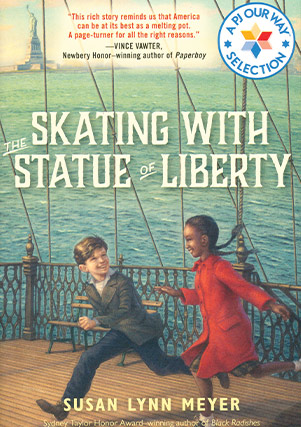Skating with the Statue of Liberty
Average Rating
What the Book is About
In this sequel to Black Radishes, Gustave and his family have escaped Nazi-occupied France and are now living in New York. Although they are safe, life isn’t easy for the Beckers. The family struggles to make ends meet and they live in a cramped apartment. Gustave gradually learns American ways, but he is shocked to discover prejudice and inequality even in the land of opportunity, and when he becomes friends with September Rose, who is African-American, he must decide whether to stand by her or abandon their friendship to fit in.
Jewish Content & Values
- The Beckers are a Jewish family who escaped Nazi-occupied France and are now immigrants in New York City. They worry about the fate of their Jewish family and friends still in Europe and ask the Hebrew Immigrant Aid Society for help in finding them.
- Gustave and his family attend the French Synagogue in Manhattan. There is kiddush (prayers followed by a snack including challah) after the service. The family discuss whether it is acceptable to take the bus to the synagogue across town on the sabbath.
- Gustave joins a French-American Jewish boy scout troop. They experience anti-Semitism when the owner of an inn refuses to serve them because the leader of the Jewish troop wears a kippah (skullcap, or yarmulke in Yiddish).
- Gustave has bar mitzvah lessons with Rabbi Blum.
Positive Role Models
- Gustave does the right thing (behirah hofshit), and he shows courage (ometz lev) when he stands by his African-American friend September Rose even though some white people in the book have racist views and express disapproval of interracial friendship.
- Father Rene is leader of the French Catholic Boy Scouts. His troop goes on outings with the Jewish scouts, and when the inn won’t serve the Jewish boys, Father Rene won’t let his troop eat there either, even though they are very hungry.
- Rabbi Blum leads the French-Jewish boy scouts and teaches bar mitzvah classes. He patiently talks with Gustave about the boy’s doubts about the existence of God given the terrible events taking place in the world.
Content Advisory
- Jean-Paul tells Gustave ‘They kill Jews for no reason at all!’ and explains that he saw the Nazis beat an old man to death. He tells Gustave that their friend Marcel is probably dead, though it eventually turns out that Marcel is safe and in hiding.
- September Rose’s brother and his friends are activists protesting against discrimination against African-Americans. Her brother is beaten, and later the peaceful protesters are attacked by a group of white men and then beaten up by the police and arrested. There is some violence in this scene, but it is appropriate to the subject, which is topical and a good discussion-opener about racism today.
Talk it Over!
More for You
Jews have a long history in the civil rights movement. In the early twentieth century, the chairman of the department store Sears Roebuck, Julius Rosenwald, gave millions of dollars to causes in support of Southern African-Americans, including building over 5,000 schools. In the 1960s, several dozen rabbis marched with demonstrators in Selma and Birmingham AL, and around half of the civil rights lawyers in the South were Jewish. Around half of the young people who participated in the Mississippi Freedom Summer, the 1964 campaign to register African-American voters, were Jewish. More recently, in 2015, around 200 Jews took part in an 860-mile march with the NAACP (National Association for the Advancement of Colored People) from Selma to Washington, D.C., carrying a Torah the whole way.
What the Book is About
In this sequel to Black Radishes, Gustave and his family have escaped Nazi-occupied France and are now living in New York. Although they are safe, life isn’t easy for the Beckers. The family struggles to make ends meet and they live in a cramped apartment. Gustave gradually learns American ways, but he is shocked to discover prejudice and inequality even in the land of opportunity, and when he becomes friends with September Rose, who is African-American, he must decide whether to stand by her or abandon their friendship to fit in.
Jewish Content & Values
- The Beckers are a Jewish family who escaped Nazi-occupied France and are now immigrants in New York City. They worry about the fate of their Jewish family and friends still in Europe and ask the Hebrew Immigrant Aid Society for help in finding them.
- Gustave and his family attend the French Synagogue in Manhattan. There is kiddush (prayers followed by a snack including challah) after the service. The family discuss whether it is acceptable to take the bus to the synagogue across town on the sabbath.
- Gustave joins a French-American Jewish boy scout troop. They experience anti-Semitism when the owner of an inn refuses to serve them because the leader of the Jewish troop wears a kippah (skullcap, or yarmulke in Yiddish).
- Gustave has bar mitzvah lessons with Rabbi Blum.
Positive Role Models
- Gustave does the right thing (behirah hofshit), and he shows courage (ometz lev) when he stands by his African-American friend September Rose even though some white people in the book have racist views and express disapproval of interracial friendship.
- Father Rene is leader of the French Catholic Boy Scouts. His troop goes on outings with the Jewish scouts, and when the inn won’t serve the Jewish boys, Father Rene won’t let his troop eat there either, even though they are very hungry.
- Rabbi Blum leads the French-Jewish boy scouts and teaches bar mitzvah classes. He patiently talks with Gustave about the boy’s doubts about the existence of God given the terrible events taking place in the world.
Content Advisory
- Jean-Paul tells Gustave ‘They kill Jews for no reason at all!’ and explains that he saw the Nazis beat an old man to death. He tells Gustave that their friend Marcel is probably dead, though it eventually turns out that Marcel is safe and in hiding.
- September Rose’s brother and his friends are activists protesting against discrimination against African-Americans. Her brother is beaten, and later the peaceful protesters are attacked by a group of white men and then beaten up by the police and arrested. There is some violence in this scene, but it is appropriate to the subject, which is topical and a good discussion-opener about racism today.
Talk it Over!
More for You
Jews have a long history in the civil rights movement. In the early twentieth century, the chairman of the department store Sears Roebuck, Julius Rosenwald, gave millions of dollars to causes in support of Southern African-Americans, including building over 5,000 schools. In the 1960s, several dozen rabbis marched with demonstrators in Selma and Birmingham AL, and around half of the civil rights lawyers in the South were Jewish. Around half of the young people who participated in the Mississippi Freedom Summer, the 1964 campaign to register African-American voters, were Jewish. More recently, in 2015, around 200 Jews took part in an 860-mile march with the NAACP (National Association for the Advancement of Colored People) from Selma to Washington, D.C., carrying a Torah the whole way.

